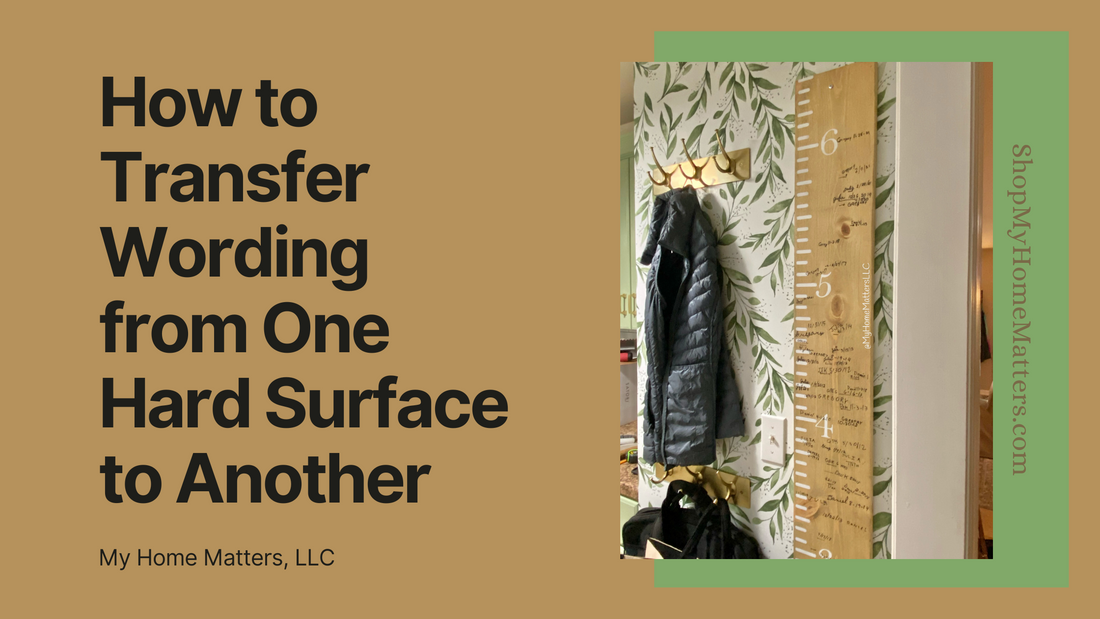
How to Transfer Wording from one Hard Surface to Another
Share
Do you have something written by a loved one that you'd like transferred onto a board or sign? My father-in-law, who passed suddenly right before Christmas of 2021, liked to measure our kids on one of his blank basement walls. I've always regretted the fact that we never had any kind of growth chart in our own home so I've been wanting to try to transfer these measurements onto a board that could hang in the laundry room. Since I've been updating that room over the last several weeks, I thought this was a great project for now! One of the challenges with this project was that he had the measurements spread out over about a two foot wide wall and I wanted to get it all onto one board about 7 inches wide. Let me show you how I figured out a way...
You can watch a quick video reel of me doing this here (on Instagram)!

1. Trace the existing wording with a #2 pencil.
Using the only see through type of paper I could think of that I had on hand, which was wax paper, I rolled out enough down the wall in two passes, overlapping and taped them together. I went to town tracing all of the markings. I recommend using a #2 pencil for this rather than a mechanical one because you need to press kind of hard to make sure it shows through well on the other side. The old fashioned #2 pencil tip is less likely to break. This really didn't take as long as I expected. Note: It is very important that you make marks at this time, while the paper is still hung, at the "foot" marks. I made a mark at six feet, 5 feet, and 3 feet just to be sure I could match those markings up on the board later. Otherwise, you won't know where to place the paper when you get to the later steps!

2. Flip the tracing paper over and trace it all over again!
Now, using that same pencil, you will flip the paper over, and trace over everything again on the back side. Make it as dark as you can with the pencil because that will help in the next step!

3. Flip the paper back over to the front side and get ready to transfer the tracings to your board.
Basically, you are going to lay the paper down where you want it. For me I needed to line up the "foot" markings with the corresponding foot markings on the growth chart sign background I had already prepared and stenciled. So wherever I wanted to put one of the kid's measurements, I had to be sure the 6' mark was lined up with the 6' mark on my paper, and so on.


I had to just move the paper side to side in order to fit all of the markings onto the 7' width I had to work with. Each time I slid it side to side, I traced over one or two measurements (press hard) and that pushed the pencil on the back side onto the board, enough to see. In some cases, it actually created grooves in the board as if it was being engraved. Either way, you just need enough markings or grooves to be able to go over it permanently with a paint pen. It's possible you could use a thin sharpie. Just beware that it could "bleed" depending on the smoothness or roughness of your board. I made sure to sand my board a lot first, but there were still a lot of dings, knots and ripples.



That's it! While it's tedious, it didn't end up being as difficult as I expected. Keep tracing until you have all of the markings there and permanently covered in paint pen. Now we have all of the markings... the last one done by my father-in-law was just about a month before he passed and my son was at about 6 feet! Now, we can keep adding to this and will always have that as a keepsake. We have no plans of covering up that original wall, but I love that we now have it on a portable sign that can be moved and go with us no matter where life takes us in the future!

Here is a pin for you to save in case you want to try this later! And, if you want to see how I transferred a recipe onto a wood cutting board cookbook holder using a completely different method, you can read that here.

